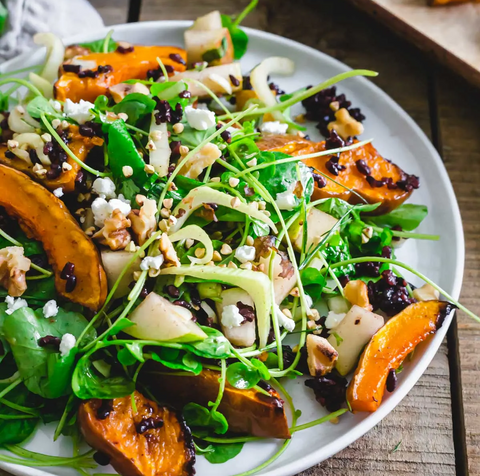Sprouted Buckwheat vs. Toasted Buckwheat
Posted on February 16 2022,

Sprouted Buckwheat vs. Toasted Buckwheat

Lil Bucks is probably one of the first sprouted buckwheat brands in the U.S.A., and while sprouted buckwheat is popular in healthy cafes in Australia, it hasn’t really blown up here yet…
So honestly I get SO excited when I see reputable brands using buckwheat, as it helps more and more Americans understand our products (and most importantly, that they’ll taste great!). I found a tiny health cafe in NYC using sprouted buckwheat in their granola recipe, a cafe in Hawaii used it as a crunchy base for a vegan dessert bar, and a smoothie shop in St. Louis offers buckwheat on their acai bowls!
AND NOW! Sweetgreen using buckwheat on their roasted Koginut squash. I LOVE sweet green for popularizing less known, in-season foods on their menu. Plus, you can really taste the freshness, and this sets them apart from other salad shops across the country. (PS this Mindbodygreen podcast with the sweetgreen founders is great!)
So I’m hoping people continue to fall in love with this crunchy, subtly nutty flavor of buckwheat, along with the nutritional benefits! And as buckwheat grows in popularity, I want to educate you on the different ways of consuming it: sweetgreen uses toasted buckwheat rather than sprouted+dehydrated buckwheat (Lil Bucks are sprouted and dehydrated), and I wanted to explore the differences in these two things, so you can learn why I prefer sprouted buckwheat vs. other forms of cooked/roasted buckwheat (but both are great!!).
WHY COOK OR SPROUT BUCKWHEAT?
Raw buckwheat contains phytic acid, a nutrient inhibitor that’s resistant to digestive enzymes and blocks the absorption of essential vitamins and minerals such as Zinc, Magnesium and Calcium. AND BUCKWHEAT HAS 25% OF YOUR DAILY VALUE OF MAGNESIUM. Sooooo um this phytic acid has got to get out of the way ?
Phytic acid is common in other seeds, nuts and legumes as well, which helps them last for years completely dormant, but isn’t great for digesting these foods. This is why you see ‘sprouted’, ‘activated’ and ‘roasted’ as popular descriptors for seeds, nuts and legumes.
Sprouting buckwheat (and other seeds, nuts and legumes) almost completely rids the buckwheat of phytic acid, so it becomes more digestible and we can better absorb all the magical nutrients. I really can’t say this better than Raw Gorilla:
“When the nut or seed is soaked it is activated and the dormant enzymes inherent inside start to awaken. Basically the nut or seed is preparing to burst into life and this is the optimum time to de-hydrate or consume them whilst they are at their enzymic peak and bursting with life-force!”
That’s why right after sprouting Lil Bucks, the buckwheat seeds are dehydrated!
Roasting (or cooking) is another way to break down the phytic acid so we can absorb the nutrients, but by doing this we are damaging some of the antioxidants found in buckwheat, and there are a LOT in buckwheat!
Some of these nutrients are sensitive to heat and might be lost during the roasting process. There still isn’t a ton of research on this as we are just starting to learn more and more about antioxidants, but multiple studies show increased temperature and roasting time decrease antioxidant activity (see sources at bottom).
You also want to be careful about the roasting method – dry-roasted or oil-roasted (can even mean deep-fried…). Dry-roasted is better but sometimes with this method, the temperature is much higher, causing more potential heat damage to the nutrients in buckwheat. I’d be interested to know how sweetgreen toasts their buckwheat – I imagine it’s a light toasting to give it that nutty flavor and ensure the phytic acid is released, but I don’t know. I’ll send them this blog post and ask! ?
APPLYING THIS PRINCIPLE TO OTHER SEEDS, NUTS AND LEGUMES
If you are thinking about the other seeds, nuts and legumes you eat, the principles for sprouting/dehydrating vs. roasting are similar, and you can follow the links below to learn more (most articles and studies don’t focus on buckwheat as much as it’s not as popular YET).
To summarize:
sprouted/dehydrated: less phytic acid, seed is dried at its most bioavailable life stage (aka when the nutrients are most available to us). Con is that if you don’t fully dry a sprouted/soaked seed/nut it can go moldy from the inside, but you can rest assured that commercially purchased sprouted seeds/nuts (like Lil Bucks) go through moisture tests to ensure they are completed dried 🙂
roasting: slightly more phytic acid than if sprouted, but much easier to do at home. Less risk in roasting than sprouting as the high temperature kills off any dangerous bacteria (although risk is small unless you are eating A TON of the particular seeds/nuts/etc.), even though it kills off some antioxidants.
General rule of thumb is that if you eat a lot of roasted nuts/seeds, roasting at home is better than store-bought as you can control the temperature and oil used (if any). But sprouting (or at least soaking before roasting or better yet, dehydrating) may be the best if you’re eating a lot of seeds/nuts to ensure you aren’t consuming too much phytic acid, and you’re making the most out of its nutritional content. ✨
MORE READING ON THIS TOPIC:
https://thenourishinghome.com/2012/03/how-to-soak-grains-for-optimal-nutrition/
https://www.healthline.com/nutrition/raw-vs-roasted-nuts#section3
https://www.precisionnutrition.com/all-about-sprouting
https://blog.radiantlifecatalog.com/bid/69542/That-s-Nuts-A-Complete-Guide-to-Soaking-Nuts-and-Seeds
Go-To Office Brekkie - Blueberry Maple Yogurt Bowl
Your new go-to office breakfast is a crunchy, creamy, and sweet yogurt parfait.😋💙
Everything Bucks Summer Salad
If you're looking for a salad that's both refreshing and bursting with flavor, you're in for a treat! Our "Everything Bucks Szning Summer Salad" combines arugula, sautéed asparagus, strawberries, and...




0 comments